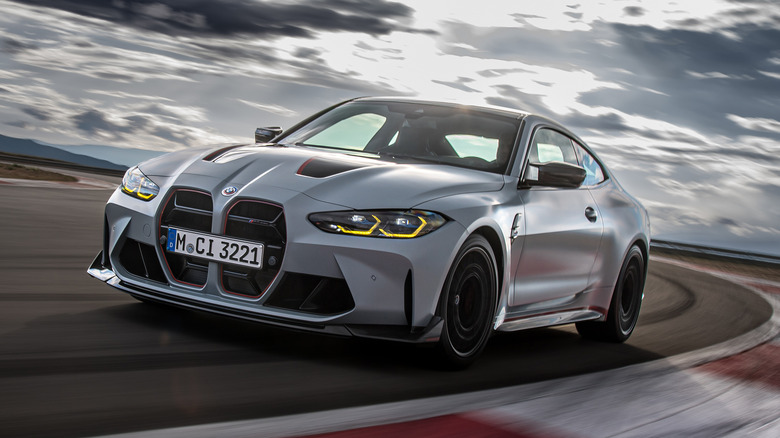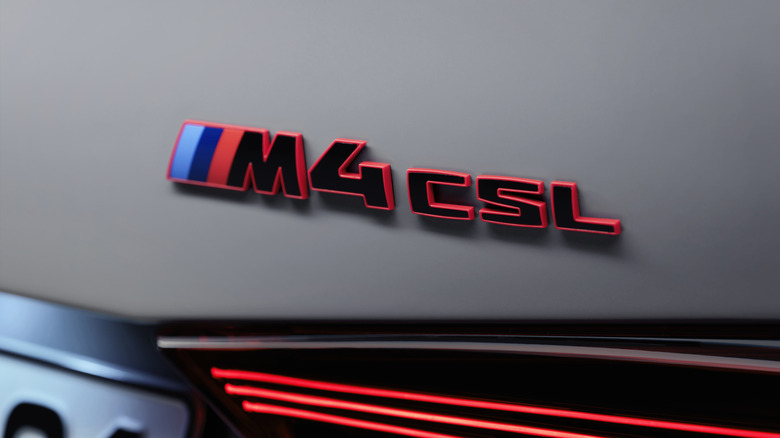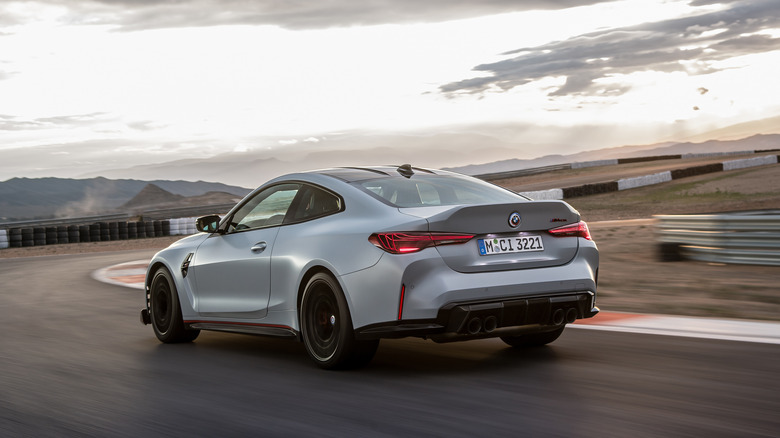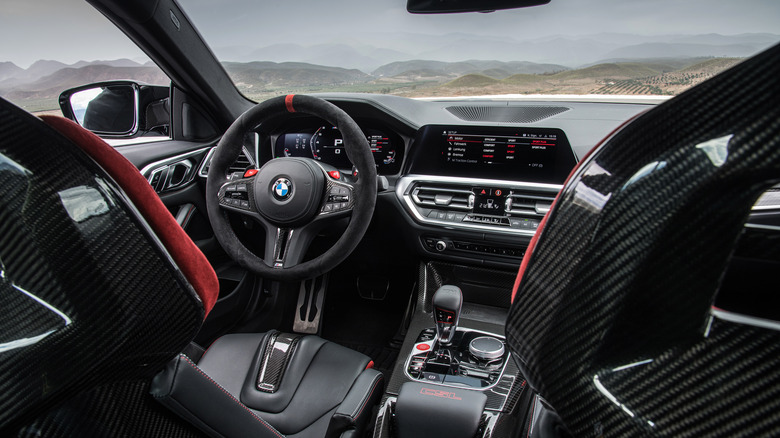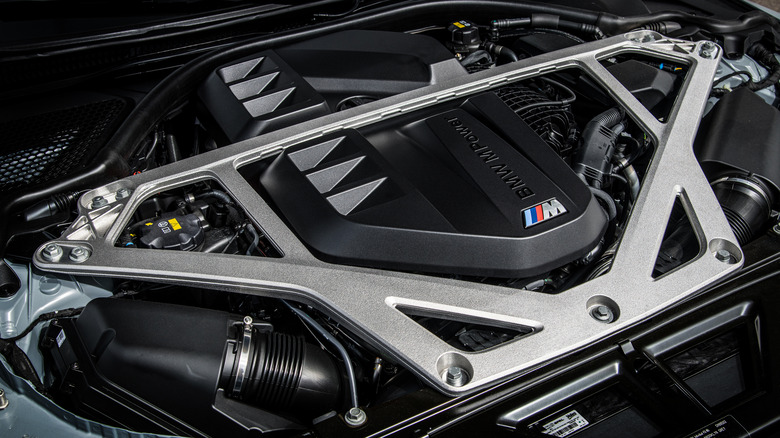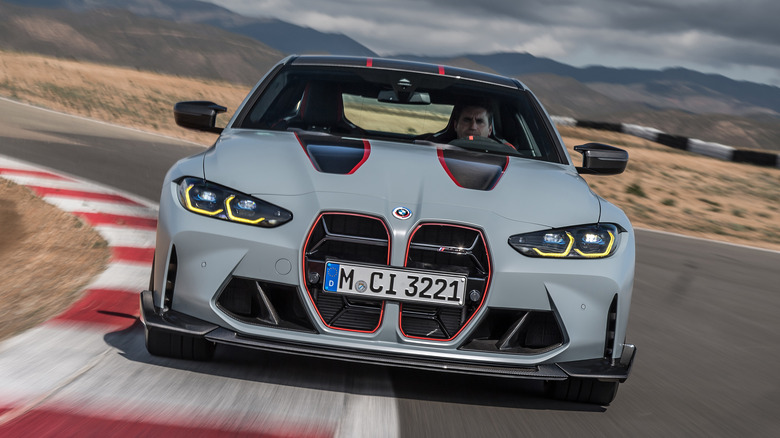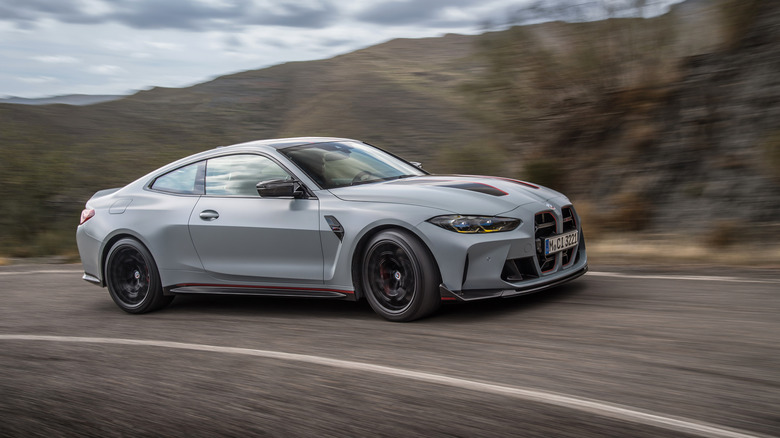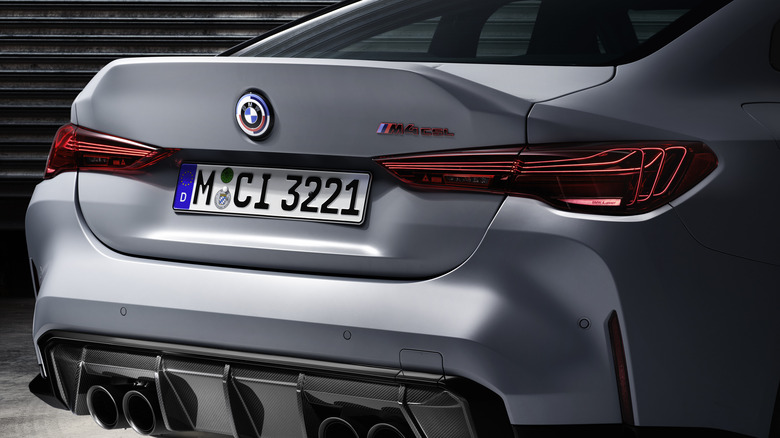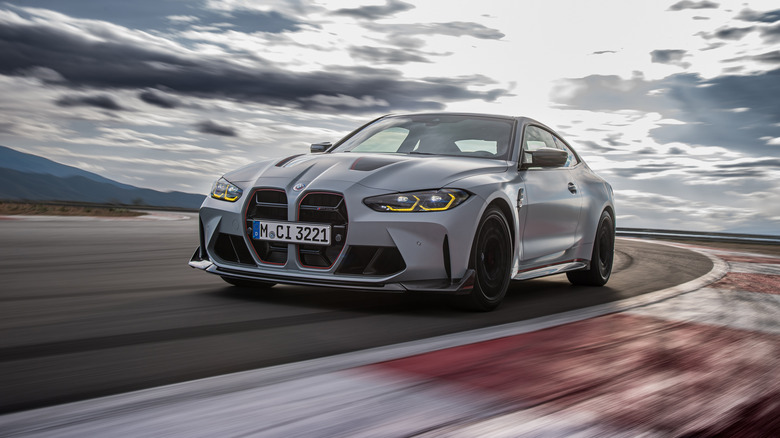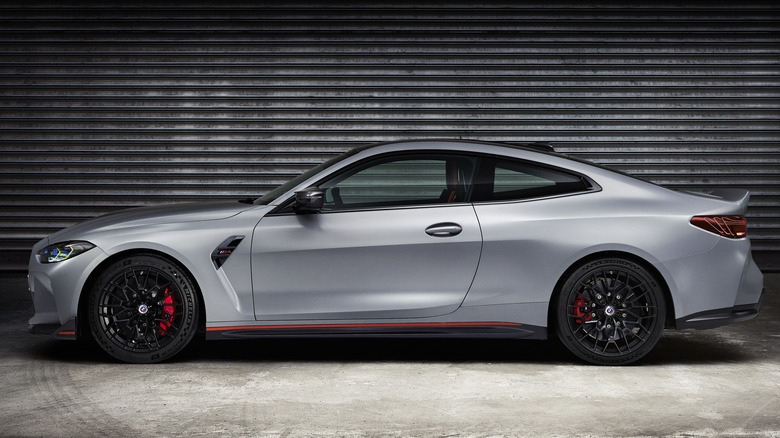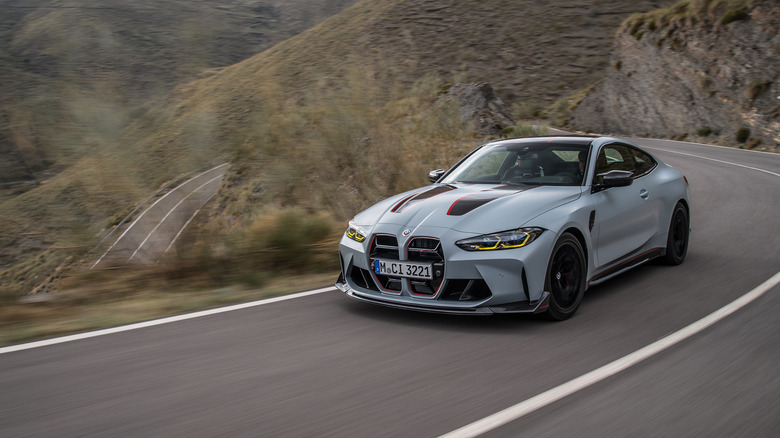2023 BMW M4 CSL: Everything You Need To Know
BMW's M division is celebrating its 50th anniversary this year, and as part of those celebrations, the company has unveiled a pair of new models. The first of those is the XM, a 750 horsepower hybrid super-SUV that should print money for the brand, but thoroughly disappointed enthusiasts when it was unveiled. After all, it's the first pure BMW M model since the M1, yet it looks like it would be more at home doing the school run than tearing up the track. Thankfully, the second new model is much more an enthusiasts' car, as it resurrects three of the most iconic letters to ever grace a BMW. That's right, the CSL is back.
The latest car to gain the "Coupe, Sport, Lightweight" moniker is the M4, a car that's already stirred up controversy in its latest form with a polarizing design highlighted by a prominent dual-kidney front grille. How good it looks might be up for debate, but its performance certainly isn't, as it's the fastest and most technically accomplished generation of the car to date. In other words, it's a perfect starting point for BMW to work its magic and create a CSL that lives up to its iconic name.
It's only the third CSL ever made
For a moniker that Top Gear called, "three of BMW's most significant letters," the CSL badge has only been used very sparingly throughout the company's history. Its first use was on the E9 3.0 CSL in the early '70s. The car was built as a homologation model for the brand to race in the European Touring Car Championship, and it was very successful, winning six overall titles throughout the decade. The car's unique selling point was its lightweight construction, featuring aluminum body panels, Perspex windows, and virtually zero soundproofing.
The name then lay dormant until 2003, when it was resurrected for use on the E46 M3. The M3 CSL is considered one of the most significant M cars of the modern era, thanks to its pioneering lightweight technology and agile handling. It wasn't necessarily the fastest BMW in a straight line, and its performance figures could be matched today by a well-specced VW Golf R. But, in terms of being fun to drive, it was up there with the best. It kept the bar high for the CSL badge and gives the new M4 CSL a lot to live up to.
Lightweight is the name of the game
There have been several recent M cars granted the "CS" moniker, but in order to earn the extra "L," the M4 CSL has been precisely engineered to be as lightweight as possible. There's a new titanium exhaust back box which saves 4.3 kg (9.5 lb) over the standard M4's version, and 15 kg (33 lb) of soundproofing is also removed. As well as keeping the car's weight down, this should enable drivers to appreciate their CSL's crisper exhaust note.
A total of 21 kg (46.3 lb) has also been shaved off thanks to revised light-alloy wheels, springs, and struts, plus a new set of carbon-ceramic brakes. The previous M3 CSL made headlines for its pioneering carbon-fiber roof, and the new M4 CSL also includes this as a weight-saving measure. In addition to the roof, the hood, boot lid, and center console are all also made of the same material, which shaves off another 11 kg (24.3 lb). These changes add up to a saving of over 113 lb compared to a standard M4.
Even the interior is lighter
But, BMW didn't stop at just making the mechanical and structural components lighter, they also made the car's interior lighter too. By fitting M Carbon bucket seats, weight has been decreased by a further 24 kg (52.9 lb). However, these seats are non-adjustable, so an option is available to add back in adjustability but at the cost of regaining some of that excess weight. When the CSL is in fully stripped-back form, changing things like the seat height requires a trip to a workshop.
The back seats of the car are also removed, and the boot trim is gone, saving a further 21 kg (46.3 lb). Where the rear seats used to be, there's now a storage cubby designed to hold two helmets, secured in place by a lightweight cargo net. This forensic approach to weight removal might seem overkill to some, especially since the CSL still tips the scales at 3,640 lb, roughly 20% more than the previous-generation M3 CSL, according to Autoblog. But, BMW promises that this new CSL will be even better to drive than the M3, even if it's not technically as light.
Its engine uses tech from the M4 GT3 car
The car's model-specific engine is based on the twin-turbo, six-cylinder unit in BMW's standard M4, but with boost technology borrowed from the GT3 racing car. In its basic construction, it's not vastly different to the standard M4, with the main differences being some unspecified tweaks to the engine management system and an increase in turbo boost. In the regular M4, the maximum charge pressure in each of the twin-scroll turbochargers is 1.7 bar, but in the CSL, it's ramped up to 2.1 bar.
BMW states that the CSL's powertrain is "focused squarely on high revs and maximum power development," and to achieve that, several race-style upgrades have been implemented. The cooling and oil supply systems have been upgraded to cope with the added pressures of frequent track driving, and a forged lightweight crankshaft can handle enhanced levels of torque. Even the engine and transmission mountings have been specially developed for the CSL, ensuring an extra layer of rigidity that the brand claims is "clearly perceptible, especially under hard driving."
Power is increased by 40 horsepower
These engine tweaks and upgrades translate to an impressive set of performance figures, most notably an increase of 40 horsepower over the standard M4. That puts total power output at 542 horsepower, marginally more than the Porsche 911 GT3, a car that some have claimed is the benchmark Bimmer is trying to beat. The CSL can pull 0-62 mph in 3.7 seconds, and 0-124 mph in just 10.7 seconds. The top speed is limited to 191 mph, considerably higher than the previous-generation M3 CSL's 155 mph limiter.
The engine is mated to an eight-speed Steptronic automatic transmission as standard, the same unit that's in the regular M4. Thankfully, BMW hasn't tried to include a CSL-specific transmission this time, as it did with the M3 CSL. Commonly referred to as the M3's biggest flaw, the jerky automatic that replaced the standard five-speed transmission was the only real negative for the car, an example of where pioneering technology sometimes doesn't work. So, it's good to see Bimmer playing it safe with the M4 CSL, sticking with the car's standard componentry.
It features unique chassis technology
Improving the CSL handle isn't just about reducing weight and adding power. The chassis has been reworked too, with new front-end strut braces to increase the car's rigidity and new aluminum elements that have been developed to adapt better to a variety of driving situations. The axles, wheel camber, and dampers have also all been fine-tuned for better performance, with BMW emphasizing in their press release that this increases the car's agility both on the road and on the track.
The suspension has also been lowered by 8mm over the standard M4, and the springs and damping response have been altered for better cornering. M Traction Control features as standard with model-specific tuning, with configurable options to allow drivers to perform controlled drifts should they want. There is also the option to set the CSL's traction system up in a similar manner to the GT3 touring car, for more serious racing. The term "race car for the road" is often overused when talking about performance cars, but here it seems appropriate. Although, given the BMW's M-car roots, perhaps "road car for racing" would more accurately sum up the CSL.
Even the lights are special
The M4 CSL features BMW's Laserlight technology, which illuminates in yellow rather than white, and has been used in the brand's endurance racing cars in recent years. This gives the headlights a distinctive look from the standard car, more akin to the styling of the range-topping M8. The CSL's taillights are also unique, and they feature technology that's making its debut in a series-produced car.
The taillights themselves use LEDs, but the glass covers have light threads woven into them that are illuminated with lasers, helping to create a distinctive look that's visible over a long distance in the dark. There are three threads, which run parallel then overlap in the outer area of the light, creating a pattern that should mark the M4 CSL out from other, lesser BMWs. It's not entirely clear whether this new technology is included on the CSL as a way of weight-saving or just simply showing off the brand's latest innovation, but either way, it's a neat feature that will undoubtedly make its way to other production BMWs in the near future.
It's the fastest BMW ever around the Nordschleife
Unsurprisingly, in their quest to prove the CSL's track dominance, BMW headed straight to the Nordschleife, a circuit that's probably now more famous as being a production car proving ground than anything to do with its motorsport history. Even less surprisingly, the car blitzed the previous production BMW lap record, posting a time of 7:20.207 for the full 20.8-kilometer circuit. It's the fastest production BMW to ever lap the Nordschleife, but it's still a long way off the time of its rival, the Porsche 911 GT3, which clocked a time of just under seven minutes.
BMW does note in its press material, however, that the full lap time is inclusive of a 0.2-mile straight that's often ignored when measuring production car lap times, and if this straight is discounted, the time is reduced to 7:15.677. An impressive figure no doubt, but it's worth noting that Bimmer only compares the time to its other production vehicles and not to any of the CSL's competition from other manufacturers. Often, press releases will boast of setting the fastest Nordschleife lap time ever for their new car's segment. But, despite the CSL's improvements, it doesn't quite have the pace to beat its rivals outright.
Production begins in July 2022
The CSL was only officially unveiled at the Concorso d'Eleganza Villa d'Este in late May 2022, but it seems that BMW is already about to start production. The first units are set to be built in July 2022, at the firm's Dingolfing plant in Germany. Production will be limited to 1,000 units, slightly less than the M3 CSL's 1,383 units, but more than the original 3.0 CSL, which sold just 785 units between 1971 and 1975.
A fixed proportion of the 1,000 cars will be available for each global market, although it's not known at the moment how many examples will be available for US buyers. It has been confirmed that 100 examples will be available for the UK market, and it's reasonable to assume that at least that number will be allocated to the German market, leaving an estimated 800 units to be shared around the remaining global markets. No matter how many units are available for Americans, the car is likely to be heavily oversubscribed, so anyone who hasn't reserved their CSL already is likely to have to sign up for a waiting list if they want the chance to buy one.
It will cost $140,000 in the US
Pricing for the M4 CSL will start at $140,895, an increase of almost double over the base-spec M4's $75,000 starting price. That's an awful lot of money for a comparatively small performance increase, and it puts the CSL close to the starting price of a Porsche 911 GT3, which costs $161,000. As previously mentioned, the rarity and once-in-a-generation chance for buyers to get their hands on a CSL-badged car will undoubtedly mean that the car sells out in double-quick time. But, its overall value compared to the rest of the market remains to be seen.
As of the time of writing, no one has been able to conduct a thorough hands-on review of the M4 CSL, and that's really what's needed to decide whether it's worth the money. By using the CSL badge as sparingly as they have done, BMW has, by its own admission, set the bar for the new M4 very high. Buyers will expect a car that's every bit as memorable to drive as the M3 CSL or the 3.0 CSL, but it seems like the company has obsessed over every detail of the new car to ensure they're not disappointed.
